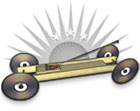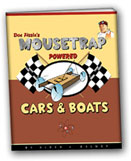Mousetrap Cars: Build a Distance Traveler
Learn the secrets to building your own long-distance-traveling mousetrap powered vehicle. You cannot build a winning mousetrap racer until you know the basics.
While there is no perfect design or perfect plan for the ultimate long-distance mousetrap car there are some common design elements that most top long-distance traveling mousetrap cars will all have in common. This article outlines many of those common design elements found on most record setting long-distance mousetrap racers. Keep in mind that as you build your first long-distance mousetrap vehicle you will want to find a harmonious balance between as many of these design elements as possible without over exaggerating any one concept. You will need to do a lot of testing and adjusting in order to perfect your vehicle's performance. Even if two people build the same mousetrap car following the exact same plans there are no guarantees that the two mousetrap cars will travel the same distance. Testing is so important because you will not know what the problems are with your mousetrap car until you experiment with your vehicle to see how it performs. During your testing you will want to make small changes and adjustments to your racer in order to see how these changes will effect your vehicle's performance. The only way to truly understand how to build a mousetrap car is to ask yourself the question "what if I change this?" and then make the change in order to see what will happen. A good engineer knows 99 ways something will not work and one way that it will work great, find that one way!
Common Design Elements of Distance Racer
- reduced friction bearings
- longer length lever arm
- large diameter drive wheels
- small diameter axles
- slow moving vehicles
- light weight components

Long-Distance Racer: Most top long-distance mousetrap racers will have large drive wheels, small drive axles, and long lever arms. Long-Distance Racers will be slow moving so as to decrease friction as much as possible and extend the pulling distance of the mouse trap.
Mousetrap Cars and Friction
Friction is a force that acts against the motion of all moving objects. We cannot eliminate friction totally but we can try to reduce it as much as possible. As a general rule of thumb the more moving parts a device has the greater the force of friction acting against the system. The first step in deceasing friction happens in the planning and designing of your mousetrap vehicle. As you plan your project think about all the points of friction in your design and look for ways to decrease the friction at these points. Because the number of moving components increases the friction look for ways to simplify your design as much as possible. Using a lot of gears and pulleys may be a great way to change the pulling the torque but this will also lead to more points of friction that will have to be address, look for simplicity.
Axle Points
The number one point of friction on any mousetrap car is where the axle system comes in contact with the frame of the vehicle. In most cases an axle will be in direct contact with the frame and there is a lot that can be done to decrease the friction at this contact point. Test spin your mousetrap racers wheels in order to see how friction-free they spin. If the wheels stop spinning fairly quickly then you will need to find ways to reduce the axle friction.
Friction at the axle points depends on:
- The diameter of the axle
- The pressure on the axle by the bearing
- The types of materials used for the axle and bearing

bearings: The number one point of friction on any mousetrap car is always at the bearings. Find ways to reduces the friction at the bearing points.
Air Resistance
Not really as big of an issue with slow moving long-distance mousetrap cars air resistance is still a topic that needs to be discussed. Imagine you are in a pool of water, you will find that it is easy to walk around in the water but once you try moving fast or even try running in the water you immediately feel the resistance of the water pushing back against your motion; this is the same resistance a mousetrap vehicle experiences as it tries to push it's way through the air. The faster the mousetrap vehicle moves the more air that the racer will have to push out of the way and this takes energy from the system. Design your mousetrap racer so that it can slice through the air with the least amount of resistance; design your vehicle to be aerodynamic. Try sanding and painting wood frames in order to cut down on the air resistance. Also, slow moving mousetrap vehicles will experience less friction than faster moving vehicles, design you mousetrap car to be slow moving; this can be achieved by adjusting the vehicle's gearing.
Factors that effect the air resistance:
- the speed of the vehicle
- the shape of the vehicle

air resistance: design your mousetrap car to be slow moving and aerodynamic in order to decrease the force of friction and maximize the travel distance.
Distance Racers and Gearing
The gearing of a mousetrap car determines the acceleration and the travel distance. Gearing can be adjusted to increase and/or decrease the pulling force, the torque, the travel distance, and the acceleration of a mousetrap powered vehicle. With all mousetrap cars the gearing is controlled by the length of the lever arm and/or the ratio of the drive axle to drive wheel set-up. Most record-setting long distance mousetrap vehicles are geared so that they have the smallest possible energy consumption rate or power output in order to maximize the pulling distance. Smaller power outputs produce less wasted energy and have greater efficiency. The amount of energy released by using a short lever arm or a long lever arm is the same but the length of the lever arm will determine the rate at which the energy is consumed called power output.
Gearing is controlled by the following:
- The length of the lever arm
- The diameter of drive wheel and/or drive axle set-up

bonus tip: long lever arms and larger drive wheels illustrate the correct gearing for a long-distance mousetrap car.
The Lever Arm
Changing the length of a mouse trap's snapper (or lever arm) is how you control a mousetrap vehicle's acceleration and/or travel distance. Different lengths of lever arms can be used to increase and/or decrease the pulling force and change the amount of string that can be pulled from the drive axle. Changing the length of the lever arm does not change the total energy and/or the torque produced by the mouse trap but it does change the pulling force applied to the drive axle. Longer lever arms will have less pulling force than shorter lever arm but longer lever arm will pull more string from the drive axle than shorter lever arm. Changing and/or attaching a lever arm to the mousetrap is the number one way to control a mousetrap vehicles performance.
If the lever arm is to long the pulling force will be decreased so much that the mouse trap will not have enough pulling force to keep the mousetrap vehicle moving through the entire pulling distance.

bonus tip: the length of the lever arm determines the pulling force and the length of string that can be wrapped around the drive axle.
Wheels and Axles
By changing the size of the drive wheel(s) you can speed-up or slow-down your mousetrap vehicle. Larger drive wheels have a greater travel distance per each turn than smaller drive wheel. It would make sense to use a super huge drive wheel so for each turn of this massive wheel the mousetrap vehicle will travel a super huge distance. But as the size of the drive wheel increase so does the amount of torque is required to start and keep the wheel turning. At some point a drive wheel can be so large that there is not enough force from the mouse trap to start and/or keep the wheel turning. With speed-trap racers smaller wheels will have a shorter travel distance per turn but will be much easier to accelerate and will require less pulling force to achieve the same acceleration as a larger wheel. Smaller drive wheels should be used on speed-trap racer in order to increase the acceleration and larger drive wheels should be used on long-distance travelers to cover more linear distance per rotation.
The diameter of the axle compared to the diameter of the wheel is also very important, the smaller the diameter of the axle in comparison to the diameter of the wheel the more force that will be required to accelerate the vehicle but the greater the distance of travel per rotation. This axle-to-wheel ratio is part of a mousetrap vehicle's gearing that needs to be understood in order to build the perfect racer for the contest at hand. For long distance racers a large diameter drive wheel with a small diameter drive axle is desired. For speed trap racers a smaller diameter drive wheel with a larger diameter drive axle is desired.
It is always important to understand the relationships between variables but never over exaggerate any one concept. The ideal size for an ultra big wheel on a long distance mousetrap racer seams to be somewhere between 10 and 15 inches.

bonus tip: long-distance racers should have a large drive wheel and small axle.
Power Output
Power output is the rate at which energy is being used. In a perfect universe where there was no friction this concept would not matter so much but in our real world environment friction makes a huge difference. Heat and sound are forms of friction that will eventually absorbs all the energy from your mousetrap vehicle and cause it to come to rest. Higher rates of energy output produce more heat and sound compared to smaller energy outputs. Slower moving mousetrap cars with smaller energy output will have less friction acting against their motion and use less energy therefor they will travel further. Longer lever arms and larger drive wheels decrease the power output.

bonus tip: slow moving mousetrap cars maximize the energy.
Inertia
Inertia is the resistance that an object has to a change in its state of motion, the more inertia that an object has the more force that will be required to change is state of motion. A heavy mousetrap vehicle will required more pulling force than a lighter mousetrap vehicle in order to achieve an equal acceleration. Lighter mousetrap vehicles will require less energy at the start and can use longer lever arms for more pulling distance. Always use lightweight components when building a mousetrap vehicle.

bonus tip: lightweight mousetrap vehicles require less pulling force off the start.
Rotational Inertia
Rotational inertia is the resistance an object has to changing its state of rotation. For an object that is not rotating we commonly talk about its inertia or its mass; the more mass an object has the more resistance the object will have to any change in it's state of motion. With rotational inertia we still talk about an objects mass but we include the location of it's mass with respect to the point of rotation. The greater the distance between the average mass of a rotating object and it's point of rotation the greater the rotational inertia of the object. The more the rotational inertia an object has the more torque that will be required to change the objects state of rotation. A large amount of rotational inertia can have an advantage once an object is rotating because it will be harder to change it's state of rotating. Having a wheel with a lot of rotational inertia can be a big advantage when building a long distance traveling mousetrap powered vehicle but having a wheel with a large amount of rotational inertia is a disadvantage when building a speed-trap dragster.
How does rotational inertia play into the design of a good distance-traveling mousetrap car? When building a mousetrap car for distance the goal is to convert as much of the mouse trap's starting energy into displace of the vehicle over the greatest linear distance. The starting potential energy of the mouse trap will be needed to overcome the force of friction acting against the vehicle's travel. With long-distance mousetrap cars use wheels that have as little rotational inertia as possible. If necessary, cut and remove mass from the wheels in order to decrease the rotational inertia.
There have been many mousetrap vehicle builders that have applied the concept of rotational inertial differently over the years. Some have designed and have built mousetrap powered vehicles that have a large and heavy wheel called a flywheel (sometimes made from an old record album) that is designed to store the rotational energy. The basic concept is that the mouse trap's energy will be converted into the rotational energy in the flywheel and then the flywheel's rotational inertia will keep the vehicle moving. I have seen this work but there are some serious flaws in the application of the physics. In a perfect universe the flywheel concept would always win if we were displacing only the wheel. But we are not in a perfect universe and we are not just displacing the wheel; instead, we are displace the whole car including the mouse trap. In our real world environment we have to deal with a small but important concept called friction. A mousetrap vehicle will travel further and be more efficient the slower it moves. In fact, the perfect long distance mousetrap vehicle would use energy at the exact same rate as the energy being lost to friction (this means slow moving). A flywheel will require more torque to get it rotating and this will increases the rate at which energy is consumed; the flywheel mousetrap powered vehicle will now have to depend more on it's coasting ability rather than having a maintained pulling force throughout it's travel. A good distance vehicle will have the smallest possible pulling force, the lowest possible energy output, and the smallest possible force of friction acting against the vehicle. So if you want to build a record setting mousetrap distance racer it is always best to use wheels with the least amount of rotational inertia possible.

bonus tip: cut and remove mass from the wheels in order to decrease the rotational inertia.
*Can't find what you're looking for? Ask Doc Fizzix »




